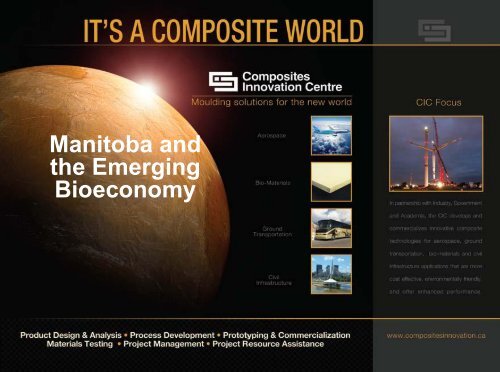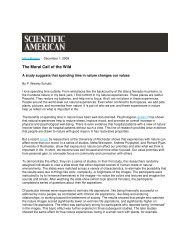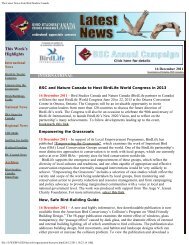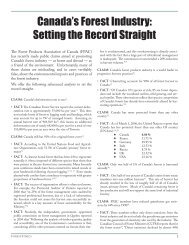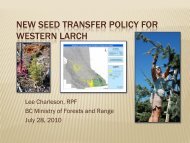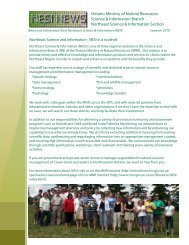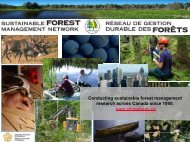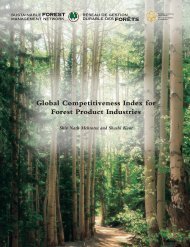Manitoba and the Emerging Bioeconomy
Manitoba and the Emerging Bioeconomy
Manitoba and the Emerging Bioeconomy
Create successful ePaper yourself
Turn your PDF publications into a flip-book with our unique Google optimized e-Paper software.
PAGE 1<br />
<strong>Manitoba</strong> <strong>and</strong><br />
<strong>the</strong> <strong>Emerging</strong><br />
<strong>Bioeconomy</strong>
Big global drivers for 21 st century change<br />
Population growth<br />
l<strong>and</strong> & water availability<br />
energy dem<strong>and</strong><br />
Climate change<br />
reduce emissions<br />
reduced water availability<br />
l<strong>and</strong> use displacement<br />
Non-renewable resource (oil, gas, coal, minerals) availability<br />
global supply & dem<strong>and</strong><br />
geo-political volatility<br />
implications for energy <strong>and</strong> materials supply<br />
These drivers are all interwoven, adding complexity to<br />
national resolution around<br />
Security of crude oil supply for transport fuel <strong>and</strong> industrial<br />
feedstocks<br />
Kyoto obligations<br />
Sustainable economic prosperity<br />
Balance of trade<br />
PAGE 2<br />
Source: C. Begley
Biomass as a subset of available resources<br />
Coal Oil Gas Minerals<br />
Human<br />
Resources<br />
Non-renewable<br />
Resources<br />
ECONOMY<br />
Renewable<br />
Resources<br />
Infrastructure<br />
Resources<br />
<strong>Bioeconomy</strong><br />
is an emerging<br />
term for <strong>the</strong><br />
sustainable<br />
production <strong>and</strong><br />
conversion of<br />
biomass to a<br />
range of food,<br />
health, fibre,<br />
industrial<br />
products <strong>and</strong><br />
energy<br />
Solar<br />
Wind<br />
Water<br />
Biomass<br />
Geo<strong>the</strong>rmal<br />
PAGE 3
<strong>Bioeconomy</strong> as a platform to a sustainable future….<br />
Low GHG, sustainable processes through<br />
agribusiness & rural re-invigoration to<br />
create secure food, industrial products <strong>and</strong> low emission energy<br />
production <strong>and</strong><br />
value added manufacturing driven by<br />
eco-innovation<br />
PAGE 4
Biobased products<br />
The Bio-economy (Industrial) Framework<br />
Pharmaceuticals<br />
Cosmaceuticals<br />
Neutraceuticals<br />
Bio actives<br />
Bio materials<br />
Bio chemicals<br />
High value<br />
manufacturin<br />
g<br />
BIO-ECONOMY<br />
I<br />
n<br />
c<br />
r<br />
e<br />
a<br />
s<br />
i<br />
n<br />
g<br />
Bio-fuels<br />
Transport<br />
fuels<br />
Low emission<br />
Secure fuel<br />
supply<br />
H 2<br />
Butanol<br />
Ethanol<br />
Biodiesel<br />
Functional<br />
Organic<br />
GM<br />
Food<br />
Feed<br />
v<br />
a<br />
l<br />
u<br />
e<br />
Biorefineries<br />
Fuel feed stocks<br />
Stationary<br />
fuels<br />
Syngas<br />
CH 4<br />
Bio-crude<br />
Coke<br />
lignin<br />
Biogenous raw materials<br />
bagasse<br />
Sustainability<br />
Sustainable<br />
rural<br />
Industry <strong>and</strong><br />
agriculture<br />
Modified from: Biorefineries – Industrial Processes <strong>and</strong> Products Status Quo <strong>and</strong> Future Directions, 2 Volumes, Brigit Kamm<br />
PAGE (Editor), 5 Patrick R. Gruber (Editor), Michael Kamm (Editor), ISBN: 3-527-31027-4, p3 & 13
Sustainable<br />
Employment<br />
The Bio-economy (Policy) Framework<br />
BIO-ECONOMY<br />
Secure supply of<br />
low carbon energy<br />
Emissions Trading<br />
Infrastructure<br />
Regulatory & Policy Frameworks<br />
Innovation<br />
PAGE 6
Biorefinery - definitions<br />
Full utilisation of biomass<br />
up to 90 %, which is a significant competitive advantage in future<br />
markets, where dem<strong>and</strong> for renewable energy <strong>and</strong> biomass raw<br />
material is much intensified.<br />
Maximising <strong>the</strong> economic value of trees / crops<br />
Heat / Energy<br />
Biochemicals<br />
(bulk <strong>and</strong> fine, functional equivalence vs identical)<br />
Biomaterials<br />
“converting <strong>the</strong> current agri- products industry to being a significant<br />
source of green power, renewable transportation fuels, <strong>and</strong>/or bio-derived<br />
industrial chemicals whilst continuing to innovate in <strong>the</strong> current products”<br />
Necessitates new business models<br />
Corporate transition & partnerships<br />
PAGE 7
PAGE 8<br />
Industry transition
MB Biomass: Opportunities & Issues<br />
Challenge: Move <strong>the</strong> industry from commodity to value-add<br />
Processing<br />
Increase profitability with existing capital<br />
Staged approach – c.f. Chambost & Stuart*<br />
Multiple product lines possible<br />
Main, co- <strong>and</strong> by-products<br />
Pre- <strong>and</strong> post-digester opportunities<br />
Hemicelluloses, black liquor gasification / lignin precipitation<br />
Biggest opportunities in biofuels <strong>and</strong> bulk & fine chemicals<br />
Feedstock optimisation<br />
Traditional breeding<br />
Biotech solutions<br />
Issues<br />
ETS<br />
Revenue streams <strong>and</strong> markets<br />
Organisational changes - partnerships<br />
Resource competition – e.g. pulp vs energy sectors<br />
Price sensitivities, public policy<br />
PAGE 9
Implementing <strong>the</strong> Biorefinery (Chambost & Stuart)<br />
Phase 1 – Lower operating costs<br />
Replacement of fossil fuels at mill<br />
Minimum risk technology<br />
Technology partnership – building blocks<br />
Phase 2 – Increase revenues<br />
Manufacture of derivatives, new products<br />
Higher complexity <strong>and</strong> technology risks<br />
Commercial partnership<br />
Phase 3 – Improve margins<br />
Knowledge-based manufacturing<br />
Process flexibility<br />
Company culture transformed<br />
Value chain partnership<br />
PAGE 10
Heat / Energy: Biomass Energy<br />
Pathways<br />
Simple heat <strong>and</strong> power generation can be made using<br />
biomass from assorted waste streams, however, more<br />
valuable industrial chemicals <strong>and</strong> liquid fuels can also be<br />
generated from biomass.<br />
Pyrolysis <strong>and</strong> Gasification of biomass produces syn<strong>the</strong>sis<br />
gas („syngas‟) a mixture of CO <strong>and</strong> hydrogen which allows a<br />
suite of catalytic <strong>and</strong> reformation reactions<br />
Fischer - Tropsch reaction which can make diesel, jet fuel<br />
<strong>and</strong> petrol.<br />
Syngas can also be used for producing industrial chemicals<br />
methanol, ethanol <strong>and</strong> dimethyl e<strong>the</strong>r.<br />
PAGE 11
Biomass to Liquid Fuel (BLF)<br />
PAGE 12<br />
http://www.biomassmagazine.com/
Lignocellulose<br />
(e.g. Forest Residues, Waste<br />
Paper, Crop Residues, Green<br />
Waste)<br />
The Furafuel Concept<br />
Furafuel Process<br />
Simple, small scale,<br />
Stable, neutral,<br />
“Bio-Crude” oil<br />
rich in furans<br />
operated close to raw materials<br />
ETHYL LEVULINATE (biodiesel)<br />
Polymers<br />
Solvents & o<strong>the</strong>r chemicals<br />
Biorefinery<br />
large, high pressure,<br />
centrally located,<br />
using known processes<br />
OCH 2 CH 3<br />
Esterification<br />
with ethanol<br />
Levulinic Acid<br />
PAGE 13<br />
Source – CSIRO/ensis
Market volume (kg/yr)<br />
Market size <strong>and</strong> price for biomass derived products<br />
Biomass derived commodities Biomass derived specialty chemicals Biomass derived Pharmaceuticals<br />
Biochemicals / Biomaterials<br />
1.00E+11<br />
cellulose-based fibres<br />
1.00E+10<br />
fatty acids<br />
1.00E+09<br />
1.00E+08<br />
speciality celluloses<br />
1.00E+07<br />
Gallic acid<br />
1.00E+06<br />
Aldehydes<br />
sterols<br />
1.00E+05<br />
1.00E+04<br />
1.00E+03<br />
1.00E+02<br />
1.00E+01<br />
essential oils<br />
chitsans <strong>and</strong> derivatives<br />
vitamins<br />
Maltol<br />
Proanthocyanidins<br />
bioactive polyphenols<br />
chiral drugs<br />
cis-3-Hexanol<br />
trans-2-Hexenal<br />
Taxans<br />
PAGE 14<br />
1.00E+00<br />
Source – Industry Canada<br />
1 10 100 1000 10000 100000<br />
Market price (US$/kg)
Project Scope: Biofibres in<br />
Transportation Applications<br />
Urethane<br />
Soy<br />
Systems<br />
MCI<br />
SWM Intl<br />
Test<br />
Facilities<br />
Mat<br />
Producers<br />
FFI<br />
Industry Partners: SWM Intl,<br />
MCI, Motive Industries<br />
Motive<br />
SWM Intl<br />
PAGE 15<br />
PROJECT HIGHLIGHTS
Biomaterials: Green Building Uses<br />
• Renewable building<br />
materials to build a<br />
demonstrator garage<br />
Material<br />
Distributors<br />
SWM Intl.<br />
Test<br />
Facilities<br />
Mat<br />
Producers<br />
Industry Partners - TBD<br />
Building<br />
Fabricators<br />
Emerson<br />
Hemp DC<br />
PAGE 16<br />
PROJECT HIGHLIGHTS
Feedstocks - Biomonomers ==> Biopolymers<br />
Biomass Biorefinery Biopolymer<br />
Proteins<br />
Lignin<br />
Starch<br />
Hemicellulose<br />
Cellulose<br />
Oils<br />
Amino acids, peptides<br />
Aromatic diacids, dihydroxy’s, hydroxyacids<br />
Di- <strong>and</strong> polyhydroxy’s<br />
Di- <strong>and</strong> polyhydroxy’s, diacids, hydroxyacids<br />
Polyamides<br />
Polyesters<br />
Polyols<br />
Polyurethanes<br />
Polyesters<br />
Polyols<br />
Polyamides<br />
Polyurethanes<br />
Polyesters<br />
Polyols<br />
Polyurethanes<br />
Polyamides<br />
PAGE 17
Lignin - issues<br />
Most abundant aromatic polymer<br />
98-99% of kraft / sulfite lignins used as fuel for process chemical<br />
recovery<br />
1-2% used for specialty chemicals:<br />
Dispersants, emulsifiers, binders<br />
Conversion to high-value products hindered by<br />
Complexity<br />
heterogeneity<br />
Polydispersity<br />
High levels of impurities<br />
PAGE 18
Products from Lignin<br />
Combustion<br />
Energy<br />
Complete degradation (pyrolysis)<br />
Methane, CO, Syngas<br />
Partial degradation<br />
Phenolics – syn<strong>the</strong>sis of polymers <strong>and</strong> resins<br />
Hybrid adhesive systems (phenolics + oils + tannin adhesives) for fibre composite<br />
systems<br />
Papermaking additive replacement (e.g. binder systems for coated papers)<br />
Sulfur-free lignins:<br />
Produced during bioethanol production, solvent or soda pulping<br />
Superior properties<br />
Substitute for phenolic powder resins<br />
Brake pads, OSB binders<br />
Polyurethane foams<br />
Epoxy resins<br />
PAGE 19
Cellulose nanocrystals<br />
Cellulose nanofibres<br />
diameters of 5–50 nm <strong>and</strong> lengths of several millimetres conformed by<br />
nanocrystalline domains <strong>and</strong> amorphous regions.<br />
nanocellulose crystals make up to 20% by mass of wood<br />
applications as reinforcements in composite materials<br />
Liquid crystal properties (nematic <strong>and</strong> chiral nematic).<br />
The mechanical properties of nanocellulose crystals<br />
tensile strength twice that of steel wire but with a comparable modulus<br />
tensile strength 25% <strong>and</strong> a modulus 25-50% of carbon nanotubes but a<br />
small fraction of <strong>the</strong> cost<br />
reinforcing agents in polymeric materials with <strong>the</strong> potential to create a<br />
green bio-steel material<br />
accessible anisotropic surface chemistry of <strong>the</strong> crystals allows for ready<br />
chemical modification<br />
crystals are biologically compatible <strong>and</strong> could be used in areas nontraditional<br />
to <strong>the</strong> forest industry such as scaffolding for medical<br />
applications <strong>and</strong> reinforcement for shape memory polymers<br />
PAGE 20
Wood Extractives<br />
Non-cell wall components<br />
Can be removed using solvents,<br />
e.g. pet. e<strong>the</strong>r, acetone, ethanol,<br />
water<br />
- Relatively small molecules (<<br />
C40)<br />
Usually comprise 1-5% of <strong>the</strong><br />
wood<br />
Under genetic control & vary by<br />
species<br />
Wood Extractives<br />
Fern<strong>and</strong>ez et al. Journal of Chromatography A<br />
922(1,2), 225-233 (2001)<br />
PAGE 21
Some extractives & <strong>the</strong>ir utilities<br />
Fatty acids<br />
Linoleic acid (dietary), Suberin (polyester)<br />
b-sitosterol<br />
Terpenoids<br />
Monoterpenes<br />
Pinene, limonene (fragrances & flavours)<br />
Diterpenes<br />
Abeitic acid, pimaric acid (resins, sizing agents)<br />
Triterpenes<br />
Betulin (medicinal)<br />
Phenolics<br />
Stilbenes (pinosylvin), flavonoids, lignans<br />
Bioactive polyphenolics can be applied to health protection (e.g.<br />
anti-oxidant properties) <strong>and</strong> disease treatment (viral <strong>and</strong> cancer<br />
treatments with podophyllotoxin/nor-dihydroguaiaretic acid<br />
derivatives).<br />
PAGE 22
Example: Betulin<br />
Has been shown to help wounds heal faster <strong>and</strong> cut inflammation.<br />
Many cosmetic companies, touting it as a skin toner <strong>and</strong> restorer, add<br />
birch bark extract to various products.<br />
Betulin can be easily converted to betulinic acid, which possesses a wide<br />
spectrum of biological <strong>and</strong> pharmacological activities.<br />
antimalarial <strong>and</strong> anti-inflammatory activities<br />
anti-HIV activity <strong>and</strong> cytotoxicity against a variety of tumor cell lines<br />
comparable to some clinically used drugs.<br />
Betulinic acid is specifically cytotoxic to several tumor cell lines<br />
(melanoma) by inducing apoptosis in cells.<br />
Fields of application:<br />
1. Raw material for pharmaceutical production;<br />
2. As a main active ingredient in parfumery-cosmetic products;<br />
PAGE 23
Poyry analysis 1<br />
•It is expected that second-generation biofuels can compete when crude<br />
oil prices are EUR 46-77 per barrel (VIEWLS 2005).<br />
production costs will be influenced by future fuel specifications,<br />
end-use issues <strong>and</strong> o<strong>the</strong>r aspects such as by-product markets.<br />
If <strong>the</strong> development <strong>and</strong> scale-up of second-generation biofuels<br />
is successful <strong>and</strong> biomass becomes <strong>and</strong> remains cheaply<br />
available, second-generation biofuels can compete at about<br />
EUR 31 per barrel.<br />
All second-generation biofuels are still in <strong>the</strong> R&D/pilot phase <strong>and</strong> are<br />
not yet available on <strong>the</strong> market because of technical limitations.<br />
Compared to first-generation biofuels, cellulosic bioethanol, FT biodiesel<br />
<strong>and</strong> HTU diesel are expected to yield far higher reductions in<br />
greenhouse gas emissions.<br />
The main environmental drawback of second-generation biofuels<br />
concerns <strong>the</strong> sources of <strong>the</strong> biomass required<br />
waste streams vs. cultivated<br />
PAGE 24<br />
Source PIRA, 2007
PAGE 25<br />
Poyry analysis 2<br />
Process flexibility<br />
a mill should be able to achieve targeted returns for <strong>the</strong><br />
integrated processes under a range of volatile market <strong>and</strong><br />
economic circumstances.<br />
optimisation <strong>and</strong> adjustment of carbon consumption to produce<br />
fibres, bioenergy, green chemicals or structural material<br />
products.<br />
what are <strong>the</strong> most attractive process variations that a mill<br />
should consider?<br />
•Energy generation<br />
how can energy systems best be integrated <strong>and</strong> optimised<br />
between <strong>the</strong> BTL plant <strong>and</strong> <strong>the</strong> existing mill?<br />
Preliminary calculations indicate that <strong>the</strong> wood-paying capability of paper<br />
production is still significantly higher than that of biofuel production<br />
taxation <strong>and</strong> subsidies will determine <strong>the</strong> competitiveness of<br />
liquid biofuels<br />
However, some assessments of economic performance indicate<br />
that <strong>the</strong> profit from co-production of FT (Fischer-Tropsch)<br />
liquids could be of similar to that from paper production. (VTT,<br />
Lahti, Nov. 2006)
Role of <strong>the</strong> market<br />
Public Policy & Market Forces<br />
Efficient allocation of resources<br />
for maximum returns<br />
Role of public policy<br />
Focus on essential societal<br />
values NOT priced – market<br />
failures<br />
Environmental impacts<br />
Zero-waste initiatives<br />
Biofuels part of a combined<br />
solution (solar, C capture)<br />
Technology development<br />
Technology clusters – e.g.<br />
gasification<br />
Public good, pre-competitive<br />
Policy integration<br />
Biomass, energy, chemicals,<br />
R&D<br />
PAGE 26
<strong>Manitoba</strong>: Biomass<br />
Agricultural biomass<br />
19 m acres of farml<strong>and</strong><br />
0.4 m acres of flax<br />
0.4 m tonnes flax straw p.a.<br />
Forest biomass<br />
65 m acres<br />
Mixture of softwood <strong>and</strong> hardwood species<br />
1.5 m m3 softwood <strong>and</strong> 0.7 m m3 hardwood p.a.<br />
1.0 m tonnes of harvest residues p.a.<br />
Waste streams – industrial <strong>and</strong> municipal<br />
Hogs, potatoes, oat hulls<br />
250,000 tonnes municipal waste biomass<br />
PAGE 27<br />
Source – <strong>Manitoba</strong> Government (Growing Green)
<strong>Manitoba</strong>: Industry<br />
MB bioproducts companies number > 30<br />
Biofuels sector<br />
Speedway International<br />
Biofibres <strong>and</strong> biomaterials<br />
Forestry – Tolko<br />
Ag-fibre – SWM International<br />
Waste streams – Solanyl Biopolymers Inc.<br />
Connecting to larger industry / OEM<br />
Composites Innovation Centre Inc.<br />
Richardson Centre for Functional Foods <strong>and</strong> Nutraceuticals<br />
PAGE 28
<strong>Manitoba</strong>: Priorities<br />
Growing Green<br />
Key principals for a successful bioeconomy sector<br />
Integration<br />
Remove “silos” between resources – multiple feedstock management<br />
(& multi-purpose crops), systems approach<br />
Whole-of-value-chain focus<br />
Alliances, collaborative <strong>and</strong> cost-sharing partnerships<br />
Innovation<br />
Bioproducts <strong>Manitoba</strong> – Innovation champion<br />
Growing <strong>and</strong> supporting bioproducts companies<br />
Clustering<br />
New technologies transferred<br />
Commitment<br />
A sustainable environment <strong>and</strong> communities<br />
Kyoto<br />
PAGE 29
Fundamental challenges<br />
Interpreting major trends in o<strong>the</strong>r jurisdictions<br />
Global big-picture view<br />
Inspirational “thought-leadership”<br />
Government policy <strong>and</strong> industry, “early-adopter” contacts, SME<br />
relationships<br />
Connectedness & information deficit<br />
Collaborations, international<br />
Critical mass – supply chain<br />
Capability cross-talk<br />
Talent retention & attraction<br />
Skills development – training<br />
Global talent shortage – international competition<br />
Yes! Winnipeg<br />
Cutting edge technology development & adaptation<br />
Appropriate resourcing & prioritisation<br />
PAGE 30
CONTACT INFORMATION<br />
Simon Potter<br />
Sector Manager – Product Innovation<br />
Adjunct Professor – University of <strong>Manitoba</strong><br />
CIC Contact Information:<br />
Website: www.compositesinnovation.ca<br />
Email: spotter@compositesinnovation.ca<br />
Tel No.: 204-262-3400 Ext 209<br />
PAGE 31


